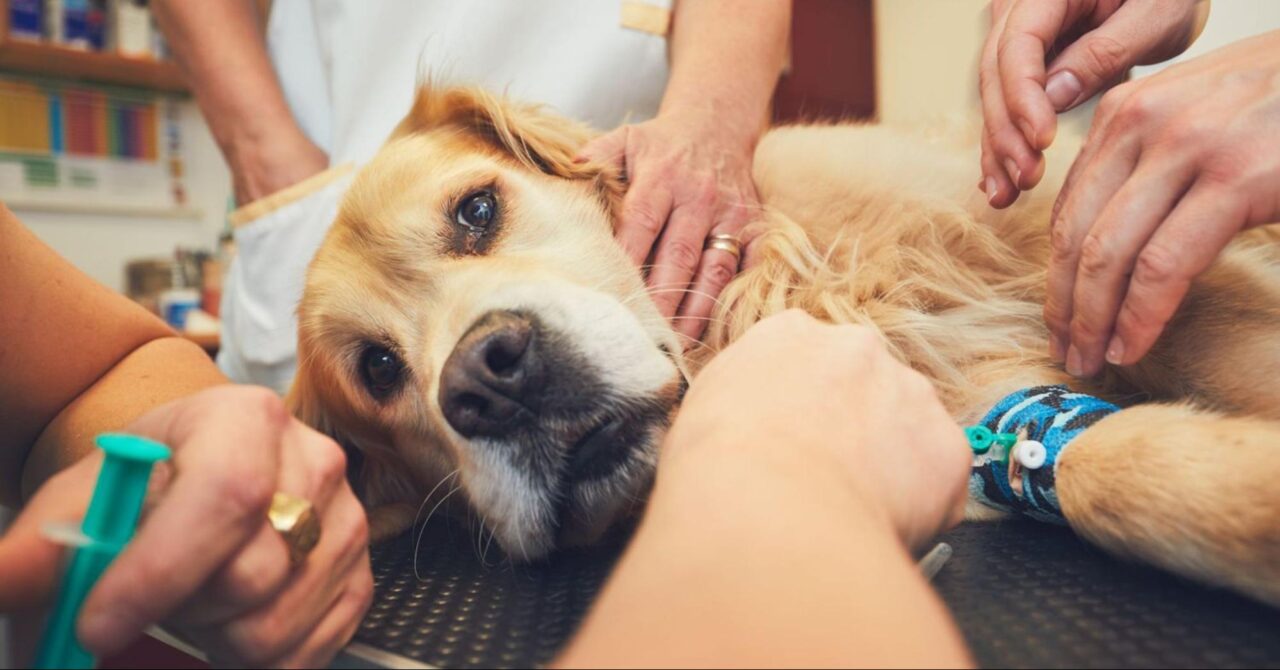
When to euthanize a dog with Cushing’s disease? Let’s have a proper guide on this!.. Cushing’s syndrome, also referred to as hyperadrenocorticism is a seen issue, in dogs. It involves the production of cortisol, a stress hormone by the glands. This condition can significantly impact a dog’s health and daily life showing a variety of symptoms that develop over time. Recognizing the signs, stages, and management of Cushing’s syndrome is key for pet owners to effectively address this issue.
This article delves into the intricacies of Cushing’s syndrome in dogs examining its symptoms progression, through stages and available treatment options. By understanding Cushing’s syndrome pet owners can advocate for their friends well being and health more effectively ultimately enhancing their overall quality of life.
When To Euthanize A Dog With Cushing’s Disease:
Making the decision to euthanize a beloved pet is never easy, but it’s ultimately an act of compassion and love. Here are factors to consider:
- Quality of Life: Assess your dog’s quality of life objectively, considering factors such as pain, mobility, appetite, and overall enjoyment of daily activities. If your dog’s suffering outweighs moments of joy and comfort, euthanasia may be the kindest option.
- Prognosis: Discuss your dog’s prognosis with your veterinarian, taking into account the severity of their condition, expected disease progression, and potential treatment outcomes. If the prognosis is poor and further interventions offer little relief, euthanasia may provide a peaceful end to your pet’s suffering.
- Pet Owner’s Well-being: Consider your own emotional well-being and ability to provide care for a chronically ill pet. While it’s natural to want to prolong your dog’s life, it’s essential to balance their needs with your capacity to offer support and comfort.
- Consultation and Support: Lean on your veterinary care team for guidance and support during this challenging time. They can offer compassionate care and assist you in making decisions aligned with your pet’s best interests.
Cushing’s disease has seriously reduced your dog’s quality of life if it affects their eating, hydration, cleanliness, skin health, and sleep. Euthanasia could be the most humane course of action at such moment, or perhaps earlier.
Is Cushing’s the same as diabetes in dogs?
No, Cushing’s disease in dogs is not the same as diabetes. Cushing’s disease is caused by a tumor on the pituitary gland that secretes too much of the hormone cortisol. This can lead to an increase in blood sugar levels similar to diabetes, but it is a different condition altogether. Diabetes in dogs is caused by insufficient insulin production or the inability to utilize existing insulin properly. Cushing’s does not cause weight loss like diabetes does. Furthermore, a dog can have both diabetes and Cushing’s disease at the same time. It is estimated that somewhere between 15-30% of dogs diagnosed with diabetes will also have a concurrent Cushing’s disease.
Diagnosing Cushing’s Disease in Dogs
Tests performed to diagnose Cushing’s include:
- Screening tests – urine cortisol ratios
- Differentiation tests
- Ultrasound
The most common method of diagnosis includes an ACTH stimulation test, which checks for an abnormally high level of cortisol in the dog’s body. Additional tests that may be done include a urinalysis, complete blood count (CBC), biochemical profile, and ultrasound. These tests confirm the diagnosis and rule out other potential diseases and conditions that may be causing similar symptoms.
What treatments are available?
Dogs with mild symptoms will be closely monitored before treatment begins.
Other treatment options involve destroying enough of the adrenal gland to reduce the secretion of cortisol when administered very carefully.
Oral medications can suppress cortisol production and will be needed for life. As these drugs can have serious potential side effects, your dog must be tested frequently. Common side effects include poor appetite, vomiting, and lack of energy. More serious complications can involve collapse, severe hormone imbalances, destruction of the adrenal glands, and even death.
Your pet may need surgery to remove an adrenal tumor, and you should follow the vet’s instructions strictly. You’ll need to watch out for signs of internal bleeding, such as pale gums, rapid breathing, and general weakness. There are many potential risks for surgery as it’s incredibly complex. And surgical techniques to remove pituitary tumors aren’t widely available.
What happens when you leave Cushing’s untreated?
Generally, an untreated dog can live as long as a treated dog but with side effects. Treatment doesn’t change the lifespan. However, it gives a better quality of life when you address the symptoms.
Complications may occur in the form of diabetes or a blood clot in the lungs. Moreover, hypoadrenal corticism, if left untreated, can lead to death.
How long does a dog live with Cushing’s Disease?
The ultimate age for a dog to survive with Cushing’s is approximately three years. However, in some cases, the survival rate is two years.
Dogs with the disease can have a good quality of life if a vet closely monitors them. This means regular check-ups, blood work, and administering any required medication.
Final Stages of Cushing’s in Dogs
As Cushing’s disease progresses to its final stages in dogs, health complications like those involving the heart, kidneys, and spleen may arise. Warning signs include uncontrollable urination and excessive drinking. Acute cases may consist of additional physical symptoms such as vomiting or diarrhea, whereas chronic stages typically involve changes in behavior or appearance but no apparent physical abnormalities.
Warning signs:
- uncontrollable urination
- excessive drinking
Unfortunately, due to the overlap of symptoms that Cushing causes with other conditions, accurately diagnosing it in its latter stages can be difficult for owners and veterinarians.
What are the symptoms of a dog dying from Cushing’s disease?
Cushing’s disease, in dogs, is a condition where their hormones become imbalanced leading to mental challenges for your pet. The main culprit in this scenario is a hormone called cortisol, which typically plays a role in regulating stress levels, blood sugar levels, immune system activity, and weight in dogs. It’s also referred to as hyperadrenocorticism. This issue may arise due to a tumor on either the pituitary glands or from the use of steroids.
Identifying Cushing’s disease in your dog can be tricky as it can present itself in ways with symptoms appearing depending on factors such as age and breed. Keep an eye out for indications, like;
⦁ Your dog drinking a lot more water than usual
⦁ Peeing way more often
⦁ Suddenly chowing down more food
⦁ Thinning fur or bald patches
⦁ Packing on the pounds quickly
⦁ Getting out of breath or panting with just a little activity
⦁ Feeling lethargic or low on energy
⦁ Seeing swelling in the belly area
⦁ Noticing skin changes like darker spots, thinner skin, or skin infections
⦁ A weaker immune system
⦁ Muscles wasting away
Here’s the tricky part: any of these symptoms could also be caused by other health issues in your dog. That’s what makes diagnosing Cushing’s disease a bit of a puzzle. But vets have a few tricks up their sleeves to figure it out:
⦁ They might start with a urine test to check for things like urinary tract infections or kidney issues.
⦁ If the urine test suggests Cushing’s, they’ll likely move on to an ACTH stimulation test to see how the adrenal glands are doing. This test looks at how the adrenal glands respond to a hormone called ACTH, which normally triggers cortisol production.
⦁ Another test involves giving your dog a low dose of dexamethasone, a synthetic cortisol, to see how their body reacts.
These tests help vets piece together whether your pup is dealing with Cushing’s disease or something else entirely.
Final Stages of Cushing’s Disease in Dogs and Treatment Options

Cushing’s disease can further result in serious health problems in dogs that can affect the heart, kidneys, and spleen. Watch out for symptoms like uncontrolled urination and excessive thirst. By this point, your pet may vomit or experience diarrhea due to a variety of factors such as acute illness or chronic infection, while at the same time, you are likely to observe some differences in his behavior or look even if no apparent physical defects are there.
Here are the Warning signs:
⦁ Peeing everywhere
⦁ Drinking a lot more than usual
Unfortunately, diagnosing Cushing’s disease in its later stages can be tough because its symptoms overlap with those of other conditions. This can make it challenging for both pet owners and vets to pinpoint what’s going on.
Treatment Options
In the final stages of the disease, treatment may focus on managing the symptoms and improving the dog’s quality of life. This may include:
⦁ Medications to reduce cortisol levels.
⦁ Dietary changes.
⦁ Supportive care to address any secondary complications.
Developing a close working relationship with your vet is vital to coming up with a treatment strategy addressing the specific needs of an individual dog and enhancing its wellness. Owners of dogs that are suffering from Cushing’s disease should be ready for the possibility of hospice care at the final stages of the illness. This could involve manipulating pain, changing its diet or even giving it supportive services which will make your pet remain content and comfortable during its last moments.
Cushing syndrome Dog back legs
Cushing’s Syndrome can have severe impacts on the dog’s back legs due to its influence on muscle strength. A lot of cortisol, a hormone associated with stress response, metabolism, and immune function can cause muscle weakness, especially in the hind limbs. In the progress of this disease, this weakness may be more pronounced thus affecting mobility and coordination.
Life expectancy of a dog with Cushing’s and diabetes
The lifespan of a dog suffering from both Cushing’s disease and diabetes varies depending on several aspects. These may include age, overall health, and how well the diseases are controlled through treatment. However, many dogs can have admirable lives despite these challenges provided they are guided properly.
Survival Rates for Pets with Cushing’s Disease
Time Since Diagnosis Survival Rate
After 1 year 70%
After 2 years 50%
After 4 years 20%
How Long Can a Dog Live with Cushing’s Disease Without Treatment

The life duration for an untreated dog suffering from Cushing’s disease is significantly different and, in general, shorter than for dogs receiving medical attention. Some dogs can live for some months to several years without treatment depending on individual factors such as how severe the disease is and the overall health of the animal. However, with well-managed illness, they will feel better before dying from other causes.
Stages of Cushing’s syndrome in dogs
- Early stage: Early on you might notice that your pet drinks and urinates more frequently, increased appetite or weight gain despite reduced exercise, panting heavily, and having a pot-bellied appearance due to abdominal enlargement.
- Intermediate stage: The condition may progress further as indicated by worsening symptoms. Prominent among these are hair loss (alopecia) resulting in thinning of hairs along the trunk with relative sparing over the legs, skin infections, thin skin, and muscle weakness.
- Advanced stage: In late stages, there may be marked muscle wasting (atrophy), weakness particularly in the hind limbs, dullness/lethargy/sluggishness; increased susceptibility to intercurrent bacterial infections notably urinary tract infection (UTI) and diabetes mellitus secondary to prolonged hypercortisolism-induced insulin resistance.
Symptoms of Advanced Cushing’s Disease in Dogs
Dogs suffering from the last stages of Cushing’s disease, often appear with big stomachs, loose hair on the sides, and thin skin. What is more, their immune systems may be weakened hence leading to recurring cases of infection.
FAQs
Is Cushing’s disease in dogs always fatal?
Not always fatal. It cannot be cured but it can be effectively managed. Dogs suffering from Cushing’s syndrome can live relatively normal lives if they receive good care and monitoring.
Do dogs with Cushing’s disease suffer?
Yes, dogs may suffer when this condition is not treated. They have a higher risk of infections such as the urinary tract and skin due to weak immune systems. They may become feeble, fall sickly, and be disinterested in activities such as playing or running that used to make them happy before. Besides that, it can cause liver disease which can worsen their symptoms.
Can a dog with Cushing’s walk well?
They might have difficulty walking properly because of weakness and atrophy of muscles leading to imbalance.
Do dogs with Cushing’s disease get aggressive?
No; Cushing’s disease rarely causes aggression in pets.
What are the neurological signs of Cushing’s disease in dogs?
Dogs with Cushing’s disease might show signs like wobbliness or disorientation. In rare cases, they might have seizures if the tumor on their pituitary gland gets big enough.
Do dogs with Cushing’s disease smell?
They might have more accidents inside the house, and infections could cause some odors.
Does Cushing’s disease cause dogs to shake?
No, shaking isn’t a direct result of Cushing’s disease. It’s usually associated with too little cortisol, not too much.













